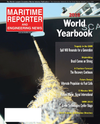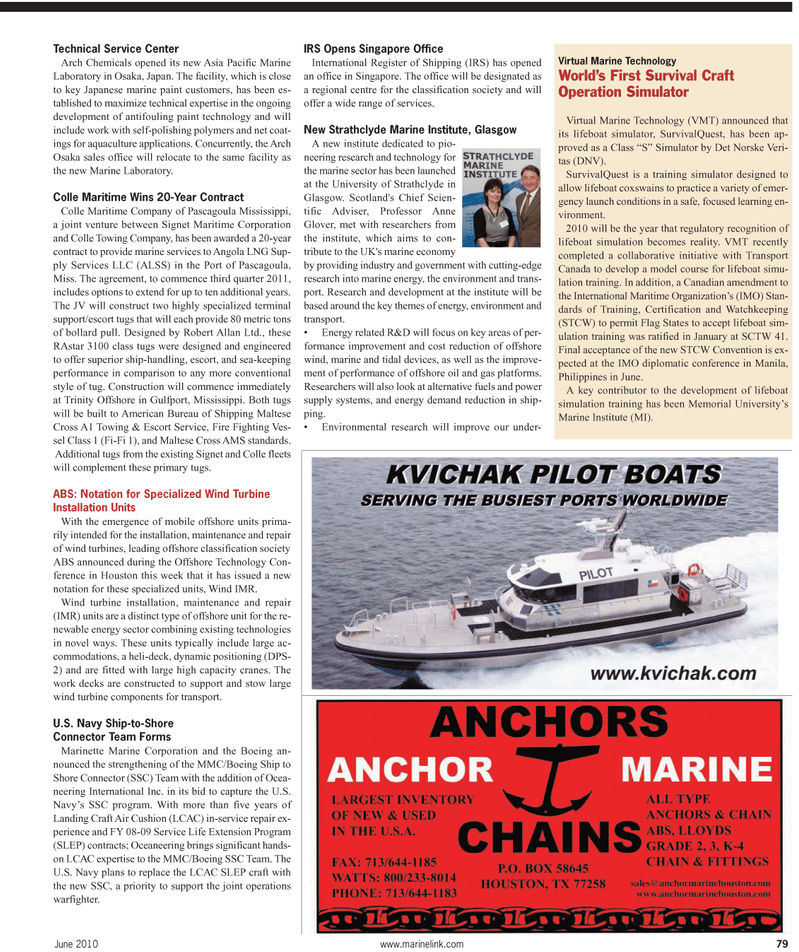
Page 79: of Maritime Reporter Magazine (June 2, 2010)
Read this page in Pdf, Flash or Html5 edition of June 2, 2010 Maritime Reporter Magazine
June 2010 www.marinelink.com 79
Technical Service Center
Arch Chemicals opened its new Asia Pacific Marine
Laboratory in Osaka, Japan. The facility, which is close to key Japanese marine paint customers, has been es- tablished to maximize technical expertise in the ongoing development of antifouling paint technology and will include work with self-polishing polymers and net coat- ings for aquaculture applications. Concurrently, the Arch
Osaka sales office will relocate to the same facility as the new Marine Laboratory.
Colle Maritime Wins 20-Year Contract
Colle Maritime Company of Pascagoula Mississippi, a joint venture between Signet Maritime Corporation and Colle Towing Company, has been awarded a 20-year contract to provide marine services to Angola LNG Sup- ply Services LLC (ALSS) in the Port of Pascagoula,
Miss. The agreement, to commence third quarter 2011, includes options to extend for up to ten additional years.
The JV will construct two highly specialized terminal support/escort tugs that will each provide 80 metric tons of bollard pull. Designed by Robert Allan Ltd., these
RAstar 3100 class tugs were designed and engineered to offer superior ship-handling, escort, and sea-keeping performance in comparison to any more conventional style of tug. Construction will commence immediately at Trinity Offshore in Gulfport, Mississippi. Both tugs will be built to American Bureau of Shipping Maltese
Cross A1 Towing & Escort Service, Fire Fighting Ves- sel Class 1 (Fi-Fi 1), and Maltese Cross AMS standards.
Additional tugs from the existing Signet and Colle fleets will complement these primary tugs.
ABS: Notation for Specialized Wind Turbine
Installation Units
With the emergence of mobile offshore units prima- rily intended for the installation, maintenance and repair of wind turbines, leading offshore classification society
ABS announced during the Offshore Technology Con- ference in Houston this week that it has issued a new notation for these specialized units, Wind IMR.
Wind turbine installation, maintenance and repair (IMR) units are a distinct type of offshore unit for the re- newable energy sector combining existing technologies in novel ways. These units typically include large ac- commodations, a heli-deck, dynamic positioning (DPS- 2) and are fitted with large high capacity cranes. The work decks are constructed to support and stow large wind turbine components for transport.
U.S. Navy Ship-to-Shore
Connector Team Forms
Marinette Marine Corporation and the Boeing an- nounced the strengthening of the MMC/Boeing Ship to
Shore Connector (SSC) Team with the addition of Ocea- neering International Inc. in its bid to capture the U.S.
Navy’s SSC program. With more than five years of
Landing Craft Air Cushion (LCAC) in-service repair ex- perience and FY 08-09 Service Life Extension Program (SLEP) contracts; Oceaneering brings significant hands- on LCAC expertise to the MMC/Boeing SSC Team. The
U.S. Navy plans to replace the LCAC SLEP craft with the new SSC, a priority to support the joint operations warfighter.
IRS Opens Singapore Office
International Register of Shipping (IRS) has opened an office in Singapore. The office will be designated as a regional centre for the classification society and will offer a wide range of services.
New Strathclyde Marine Institute, Glasgow
A new institute dedicated to pio- neering research and technology for the marine sector has been launched at the University of Strathclyde in
Glasgow. Scotland's Chief Scien- tific Adviser, Professor Anne
Glover, met with researchers from the institute, which aims to con- tribute to the UK's marine economy by providing industry and government with cutting-edge research into marine energy, the environment and trans- port. Research and development at the institute will be based around the key themes of energy, environment and transport. • Energy related R&D will focus on key areas of per- formance improvement and cost reduction of offshore wind, marine and tidal devices, as well as the improve- ment of performance of offshore oil and gas platforms.
Researchers will also look at alternative fuels and power supply systems, and energy demand reduction in ship- ping. • Environmental research will improve our under-
Virtual Marine Technology
World’s First Survival Craft
Operation Simulator
Virtual Marine Technology (VMT) announced that its lifeboat simulator, SurvivalQuest, has been ap- proved as a Class “S” Simulator by Det Norske Veri- tas (DNV).
SurvivalQuest is a training simulator designed to allow lifeboat coxswains to practice a variety of emer- gency launch conditions in a safe, focused learning en- vironment. 2010 will be the year that regulatory recognition of lifeboat simulation becomes reality. VMT recently completed a collaborative initiative with Transport
Canada to develop a model course for lifeboat simu- lation training. In addition, a Canadian amendment to the International Maritime Organization’s (IMO) Stan- dards of Training, Certification and Watchkeeping (STCW) to permit Flag States to accept lifeboat sim- ulation training was ratified in January at SCTW 41.
Final acceptance of the new STCW Convention is ex- pected at the IMO diplomatic conference in Manila,
Philippines in June.
A key contributor to the development of lifeboat simulation training has been Memorial University’s
Marine Institute (MI).

 78
78

 80
80
